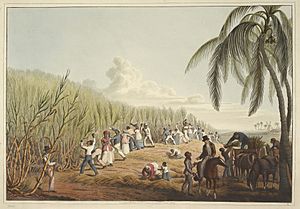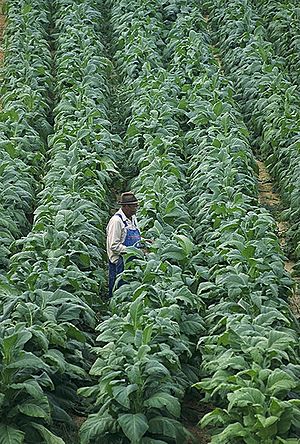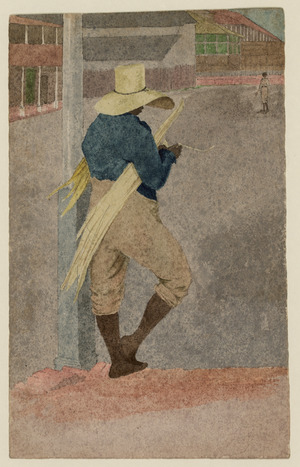Slave plantation facts for kids
A plantation was a large farm where people were forced to work, often without pay. These farms mostly grew crops like sugar, tobacco, or cotton. Sadly, many plantations used enslaved people for labor. This practice was stopped in most parts of the world during the 1800s.
Contents
What Was Slavery on Plantations?
Plantation owners started using enslaved people because other workers, like indentured servants, became too expensive. Also, many indentured servants were leaving to start their own farms. There was a lot of land available for them. Colonists first tried to use Native Americans for labor. However, many Native Americans got sick and died from European diseases.
Because of this, plantation owners turned to enslaved Africans for labor. In 1665, there were fewer than 500 Africans in Virginia. But by 1750, about 85% of the 235,000 enslaved people lived in the Southern colonies, including Virginia. Africans made up 40% of the South's population.
According to the 1840 United States Census, about one in four families in Virginia owned enslaved people. More than 100 plantation owners had over 100 enslaved people each. In the 15 states where slavery was legal, nearly 4 million enslaved people lived. This was about 32% of the total population.
- In the Lower South, about 2.3 million enslaved people lived. This was 47% of the total population there.
- In the Upper South, about 1.2 million enslaved people lived. This was 29% of the total population.
- In the Border States, about 432,000 enslaved people lived. This was 13% of the total population.
Before the American Civil War, fewer than one-third of Southern families owned enslaved people. In Mississippi and South Carolina, this number was closer to half. The total number of slave owners was about 385,000. This included some free African Americans in Louisiana. This group made up about 3.8% of the population in the Southern and Border states.
On a plantation with more than 100 enslaved people, the value of the enslaved people was higher than the value of the land and farm tools.
The first plantations started in the Caribbean islands, especially Hispaniola. Spaniards began this system in the early 1500s. The plantation system relied on enslaved labor and used very unfair and harsh ways of making people work. After the Caribbean, the system spread to European colonies in the Americas and Asia during the 1500s, 1600s, and 1700s.
All plantation systems used some form of slavery. At first, Native Americans were forced to work. Later, the system included people shipped from Africa. The growth of plantations led to a rapid increase in the slave trade.
The plantation system was at its peak in the early 1700s. Later, in the mid-1800s, European countries needed a lot more cotton. This meant plantations in the southern United States grew even more. The system faced big challenges until it changed. It moved from forced slave labor to mostly low-paid workers. These workers still included a smaller number of forced laborers. Plantation owners made high profits by having cheap labor and forcing people to work, often trapped by debt.
The Atlantic Slave Trade
European slave traders brought enslaved Africans from Africa to the Americas. They were shipped from ports in West Africa to European colonies. The journey across the Atlantic Ocean was called "the Middle Passage". It was one part of the triangular trade route. This route connected Europe, the Americas, and Africa.
Some estimates say that about ten million Africans were brought to the Americas. Only about 6% ended up in the North American colonies. Most were taken to the Caribbean colonies and South America. Many people did not survive the journey because of disease and illness. Below the decks of the slave ships, Africans were packed very tightly. They could barely move. There was a lot of waste and urine, which caused people to get sick and die.
As the plantation economy grew, the slave trade also grew. This was to meet the increasing need for workers.
Europe's Industrial Revolution
Western Europe was the main place where plantation products ended up. At this time, Europe was starting to industrialize. This meant they were building many factories and needed a lot of materials to make goods. Europe was a powerful center of the world. They used the New World (the Americas) and Africa to help them industrialize. Africa supplied enslaved people for the plantations. The New World produced raw materials for European factories. Then, manufactured goods, which were worth more, were sold back to Africa and the New World. European merchants mostly ran this whole system.
Sugar Plantations
Sugar has a long history as a plantation crop. Growing sugar needed a very precise scientific system to make money. Sugar plantations everywhere used a huge amount of labor, often enslaved people. This was because many workers died on these plantations. In Brazil, sugar plantations were called casas grandes. They had similar problems.
The enslaved people working on sugar plantations faced endless, hard work year after year. Sugarcane is harvested about 18 months after it is planted. Plantations usually divided their land to be efficient. One part of the land was resting, one part was growing cane, and the last part was being harvested.
During the rainy season (December to May), enslaved people planted, added fertilizer from animal dung, and removed weeds. From January to June, they harvested the cane. They chopped the plants close to the ground, stripped the leaves, and cut them into shorter pieces. These pieces were then bundled and sent to the sugar cane mill.
At the mill, the cane was crushed using a special three-roller mill. The juice from the crushed cane was then boiled until it crystallized into sugar. Some plantations also went a step further. They distilled the molasses, which is the liquid left after the sugar is boiled. This was used to make rum. The sugar was then shipped back to Europe. For the enslaved worker, the hard routine started all over again.
In the 1800s, slavery was abolished. Plantations continued to grow sugar cane. However, sugar beets, which can grow in cooler climates, started to take a bigger share of the sugar market.
Indigo Plantations
Indigofera was an important crop grown in the 1700s. It was cultivated in Venezuela, Guatemala, and Haiti. Haiti grew indigo until the slave rebellion against France. After that, Europe embargoed Haiti. Indigo was also grown in India in the 1800s and 1900s. The indigo crop was grown to make blue indigo dye before factories made dyes.
Mahatma Gandhi looked into complaints from indigo workers about unfair treatment. This led to the Champaran Agrarian Bill being passed in 1917 by the Government of India.
See also
Images for kids







